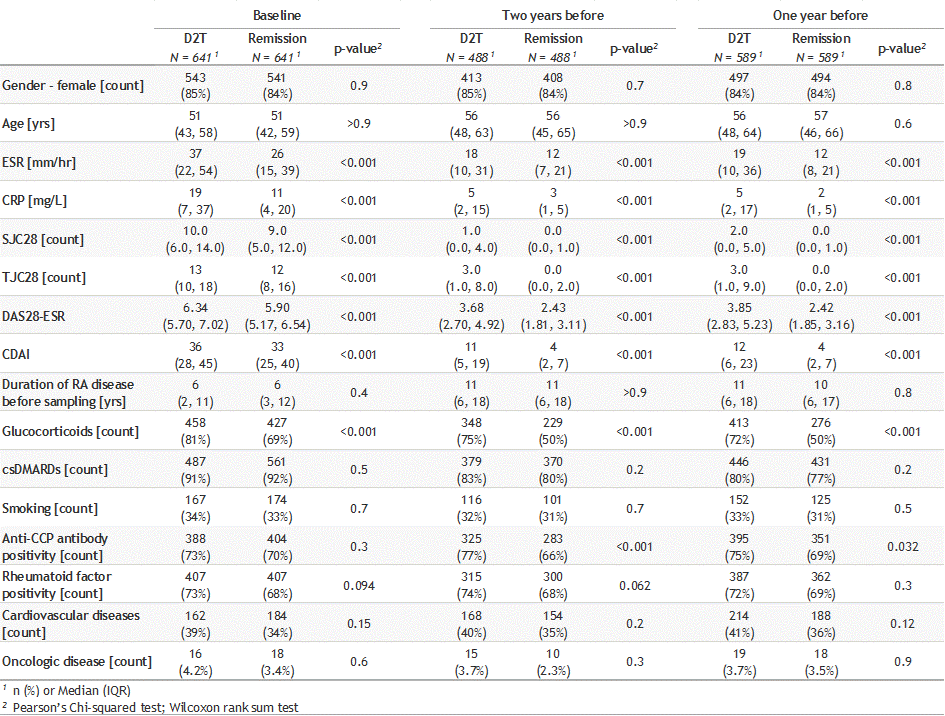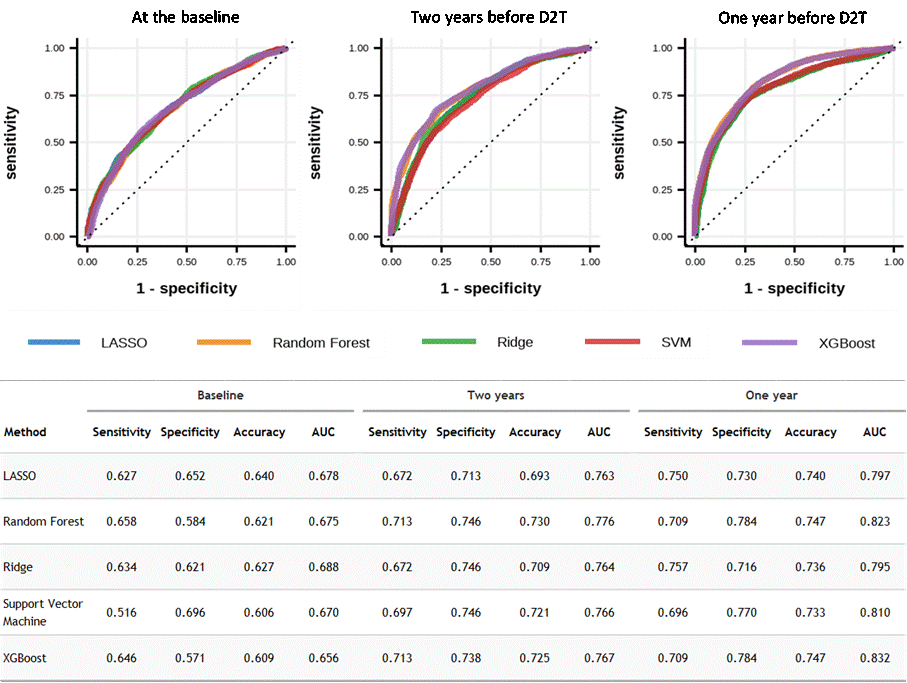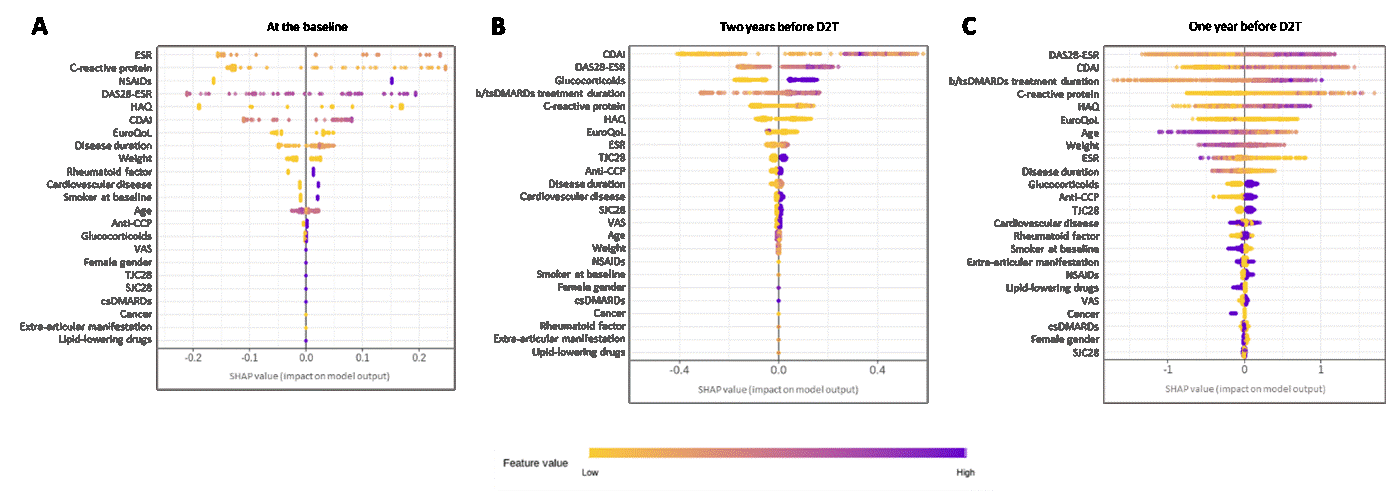Session Information
Session Type: Poster Session C
Session Time: 10:30AM-12:30PM
Background/Purpose: Despite advances in biologic (b-) and targeted synthetic (ts-) disease-modifying anti-rheumatic drugs (DMARDs), a significant subset of rheumatoid arthritis (RA) patients remain symptomatic, meeting the definition of “difficult-to-treat” (D2T) RA1.
This study aimed to identify crucial clinical indicators that can differentiate patients at risk of developing D2T RA at enrollment into the registry (baseline) or one to two years prior to meeting the definition of D2T RA.
Methods: We retrospectively analysed 8,543 RA patients from the Czech Republic biologics registry ATTRA2 (2002 – 2023) who commenced treatment with b/tsDMARDs. D2T RA was defined according to EULAR criteria 1. For comparison, we identified patients in sustained clinical remission as those with a Simple Disease Activity Index (SDAI) < 3.3 and Swollen Joint Counts (SJC) ≤ 1 over two consecutive follow-ups 12 weeks apart. All patients initiated b/tsDMARDs treatment, and their characteristics are listed in Table 1.
Results: Altogether, 641 patients with D2T RA (mean age 50.6 years at baseline; 84% female) were compared with 641 RA patients in sustained remission, matched by age, gender, disease duration, and b/tsDMARD treatment at each time point.
The machine learning model demonstrated accuracy and area under the receiver operating characteristics curve (AUC) ranges of 0.606–0.747 and 0.656–0.832, respectively, for predicting D2T RA (Figure 1). The SHAP analysis identified key predictors of D2T RA, such as clinical disease activity measures, CRP, and duration of b/tsDMARD treatment (Figure 2). The best performance of these predictors was one year before the patients met the D2T RA.
Conclusion: Our study identified clinical features that, at baseline and even up to one year before meeting the D2T RA definition, predict its development with greater likelihood. These findings provide valuable insights that could enhance the early identification and management of patients at risk for D2T RA, potentially improving treatment strategies and outcomes. Future research should focus on optimising and validating these predictive models.
Acknowledgements: Supported by SVV 260 638, MHCR 023728, NU23-10-00434.
References:
1. 1. Nagy, G. et al. EULAR definition of difficult-to-treat rheumatoid arthritis. Ann Rheum Dis 80, 31–35 (2021).
2. 2. Skácelová, M. et al. The beneficial effect of csDMARDs co-medication on drug persistence of first-line TNF inhibitor in rheumatoid arthritis patients: data from Czech ATTRA registry. Rheumatol Int 42, 803–814 (2022).
Abbreviations: ESR – erythrocyte sedimentation rate; CRP – C-reactive protein; SJC28 – Swollen 28-Joint Count; TJC28 – Tender 28-Joint Count; DAS28-ESR – Disease Activity Score 28-Joint Count with Erythrocyte Sedimentation Rate; CDAI – Clinical Disease Activity Index; csDMARDs – Conventional Synthetic Disease-Modifying Anti-Rheumatic Drugs; anti-CCP – Antibodies against cyclic citrullinated peptide.
To cite this abstract in AMA style:
Baloun J, Andrés Cerezo L, Kropáčková T, Prokopcova A, Brábníková Marešová K, Mann H, Vencovský J, Pavelka K, Šenolt L. Identifying Clinical Predictors of Difficult-to-Treat Rheumatoid Arthritis Using Machine Learning-based Techniques [abstract]. Arthritis Rheumatol. 2024; 76 (suppl 9). https://acrabstracts.org/abstract/identifying-clinical-predictors-of-difficult-to-treat-rheumatoid-arthritis-using-machine-learning-based-techniques/. Accessed .« Back to ACR Convergence 2024
ACR Meeting Abstracts - https://acrabstracts.org/abstract/identifying-clinical-predictors-of-difficult-to-treat-rheumatoid-arthritis-using-machine-learning-based-techniques/



